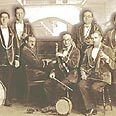
Original klezmer recordings restored
Virginian record producer rescues world's largest collection of Yiddish and Klezmer music, which had almost entirely disappeared
From his studios in rural Virginia, record producer and sound restoration expert, Christopher King, is unlocking the past. For the past seven years, he's been rescuing some 9,000 original recordings of Yiddish and klezmer melodies which had almost entirely disappeared.
Video courtesy of jn1.tv
Original melodies can be hard to hear, especially on crackly 78 rpm records.
So crudely recorded, the sound of the mechanism revolving the turntable was often captured as well.
But Christopher King does not believe in simply wiping old records clean with the latest digital technology. He is staying true to the warmth of the original tunes and the musicians themselves.
At the turn of the 20th century, the world's first record companies saw a market in klezmer and Yiddish music - both in Europe, then later among immigrants in New York.
How some klezmer groups made it into the studio, and not others, no one really knows.
What's certain, is that once klezmer music hit American soil, it evolved and assimilated - just like the immigrants that had carried it here.
"The way in which they performed was completely and totally different from and unlike anything you would have heard in American klezmer," King says.
But European klezmer was never even given the chance to evolve - because entire populations of Yiddish musicians and their audiences were wiped out.
"If you pose these weird historical questions like what would klezmer music have sounded like in Europe if there hadn't have been the Holocaust, we don't really know, but I am quite certain the music they would have been playing in the 50s and 60s would have sounded quite different," says Joel Rubin, assistant professor of music at the University of Virginia.
Rubin played a central role in the revival of Klezmer music in the United States – at a time when there were almost no living klezmer musicians left to learn from.
When he first discovered some original klezmer recordings, he started learning the melodies by ear.
Rubin performs internationally and splits his time between America and Europe.
Though he learned from the crackly recordings of Yiddish masters, his own student ensemble is diverse, securing klezmer's place in the future of world music.
But the real difference now is that his students are learning from him.
"There's a whole generation of us now, who are that link," he says. "Our students now have access to the same recordings we learned from, but of course it's much easier to learn, when you have someone showing you how to do it."
America's largest collection of Klezmer and Yiddish music was acquired by musician and philanthropist Sherry Mayrent, who is donating it to the University of Wisconsin and making available online for free.
The survival and revival of klezmer and Yiddish music would not have happened had it not been for the work of a dedicated few. And just as it was once passed on from father to son, in lands far from here, its salvage and restoration right here in the heart of Virginia means it is still being passed down – as an unbroken link – to future generations and for the world to share.










